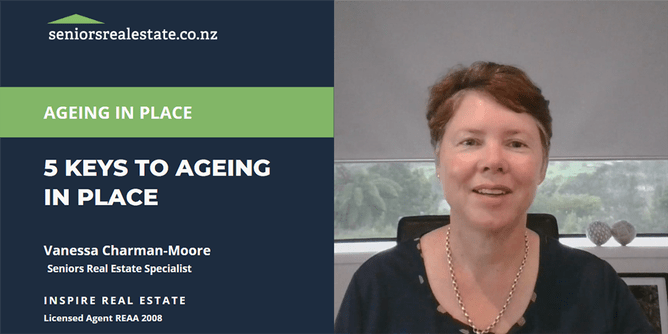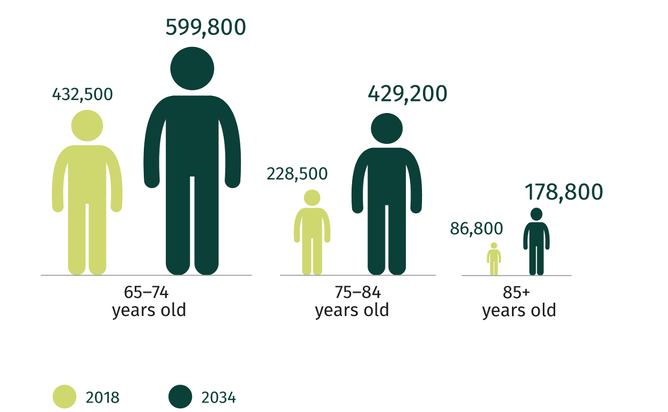How to stay in your own home
In 2002 a New Zealand policy directive named “Ageing in Place” was established with a view to supporting older people to remain in their own homes rather than having to move into residential care. In order to achieve the strategy an integrated approach to health and disability support services was proposed.
On balance, this strategy has been successful and has allowed many older New Zealanders to remain in their own homes and keep the independence that is so important later in life. However, since COVID it has become increasingly difficult to maintain the levels of health and support systems required for older people to stay in their own homes.
The ability to age in place is being further tested as the first of the baby boomers start to reach retirement age and look for low-maintenance homes with fewer bedrooms and smaller gardens than the big family homes that they currently occupy. The changing population age demographic is well illustrated by the infographic in Figure 1 and shows the significant projected increase in the numbers of those aged 65+ by 2034 which will create ongoing challenges to finding a suitable home to age in place.
Recent research indicated that 81% of 45-64-year-olds live in a stand-alone house or townhouse and 66% would prefer to live in this type of housing for life (2)
The ability to successfully age in place is largely governed by five key areas:
· Suitability of housing
· Good physical and mental health
· Community health services
· Strong social networks
· Public transportation
A variety of housing is available for those looking to downsize however there is often a waiting time for the most suitable housing. Many of the retirement villages and 55+ villages are full and have waiting lists. Smaller freehold homes can be difficult to find in a suitable price range, especially those with facilities suitable for older people. It’s worth starting the search early. Grey Power is advocating for more suitable, and a wider variety housing for older people.
When looking for a smaller home or assessing the suitability of your current home there are several key areas to check. Firstly, house access needs to be considered with a single-level house and no steps a basic starting point. Doors need to be wide enough to allow a wheelchair to access. Bathrooms require special focus with showers wide enough for easy access and with no step. Lever-style taps and handles are the easiest to use. Grab rails will add to the safety. Kitchens are best with easy-access cupboards and drawers, and benches that are suitable for wheel chair access. Loose floor coverings and mats are a hazard that cause many injuries yet can be made safer with little expense. Attach loose floor coverings with double-sided tape or purchase non-slip mats.
Having a healthy lifestyle in combination with good genetics and a little luck gives older people the best chance of ageing in their own homes. Many people will have a time when they may need to recover from a significant illness or injury. Having a plan in place that includes support and a house that is suitable for an invalid will increase the chance of being released from the hospital to your own home.
Having seamless access to health professionals is a factor in being able to stay in your own home. It is recommended keeping a list of key health professionals and to understand the support that you can get to stay in your home if illness or injury strikes or if over time some tasks become too difficult to complete.
Maintaining social networks, whether that is with family, friends or community provides connections that make it easier for older people to stay in their own homes. Technology is helping many to keep in touch with their networks by using Facebook, WhatsApp, Facetime, and other similar online applications. Some people find that it is easier to make and keep friends by being active in a sport or a hobby such as golf or bridge. Volunteering is another worthwhile avenue to create community connections; many local community groups are searching for volunteers and will be delighted to meet you. Grey Power will welcome you to monthly meetings and supporting Grey Power will help us to advocate for older New Zealanders.
Knowing that there is public transport available can take the pressure off when driving becomes difficult or impossible. In some cities there are senior drivers and community organisations that will take older people to and from medical appointments.
If you are one of the New Zealanders that likes the idea of ageing in place then start early and create a plan for your home and lifestyle that covers the five key areas above. If circumstances change you will be well-positioned to stay at home.
(1) Office for seniors Website, 65+ population 2018/2034
(2) Dr Jo Gamble (2022), Housing Intentions for People living in New Zealand aged 45-64


